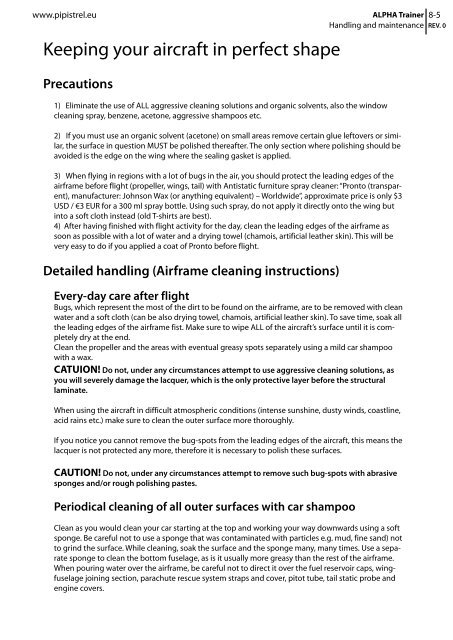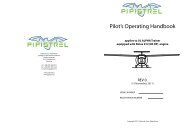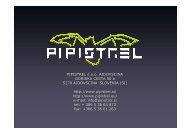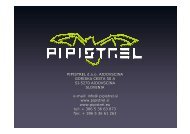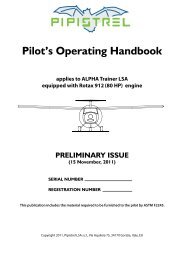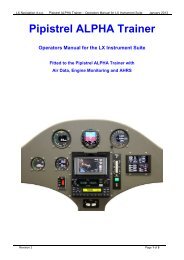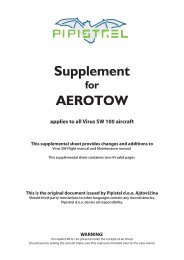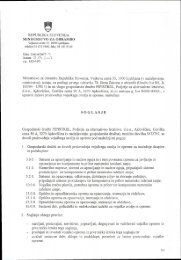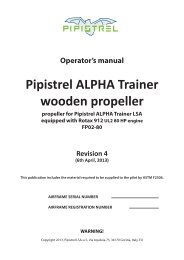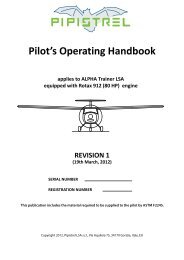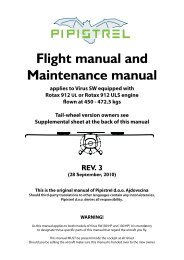You also want an ePaper? Increase the reach of your titles
YUMPU automatically turns print PDFs into web optimized ePapers that Google loves.
www.pipistrel.eu<br />
Keeping your aircraft in perfect shape<br />
Precautions<br />
1) Eliminate the use of ALL aggressive cleaning solutions and organic solvents, also the window<br />
cleaning spray, benzene, acetone, aggressive shampoos etc.<br />
<strong>ALPHA</strong> <strong>Trainer</strong> 8-5<br />
Handling and maintenance REV. 0<br />
2) If you must use an organic solvent (acetone) on small areas remove certain glue leftovers or similar,<br />
the surface in question MUST be polished thereafter. The only section where polishing should be<br />
avoided is the edge on the wing where the sealing gasket is applied.<br />
3) When flying in regions with a lot of bugs in the air, you should protect the leading edges of the<br />
airframe before flight (propeller, wings, tail) with Antistatic furniture spray cleaner: “Pronto (transparent),<br />
manufacturer: Johnson Wax (or anything equivalent) – Worldwide”, approximate price is only $3<br />
USD / €3 EUR for a 300 ml spray bottle. Using such spray, do not apply it directly onto the wing but<br />
into a soft cloth instead (old T-shirts are best).<br />
4) After having finished with flight activity for the day, clean the leading edges of the airframe as<br />
soon as possible with a lot of water and a drying towel (chamois, artificial leather skin). This will be<br />
very easy to do if you applied a coat of Pronto before flight.<br />
Detailed handling (Airframe cleaning instructions)<br />
Every-day care after flight<br />
Bugs, which represent the most of the dirt to be found on the airframe, are to be removed with clean<br />
water and a soft cloth (can be also drying towel, chamois, artificial leather skin). To save time, soak all<br />
the leading edges of the airframe fist. Make sure to wipe ALL of the aircraft’s surface until it is completely<br />
dry at the end.<br />
Clean the propeller and the areas with eventual greasy spots separately using a mild car shampoo<br />
with a wax.<br />
CATUION! Do not, under any circumstances attempt to use aggressive cleaning solutions, as<br />
you will severely damage the lacquer, which is the only protective layer before the structural<br />
laminate.<br />
When using the aircraft in difficult atmospheric conditions (intense sunshine, dusty winds, coastline,<br />
acid rains etc.) make sure to clean the outer surface more thoroughly.<br />
If you notice you cannot remove the bug-spots from the leading edges of the aircraft, this means the<br />
lacquer is not protected any more, therefore it is necessary to polish these surfaces.<br />
CAUTION! Do not, under any circumstances attempt to remove such bug-spots with abrasive<br />
sponges and/or rough polishing pastes.<br />
Periodical cleaning of all outer surfaces with car shampoo<br />
Clean as you would clean your car starting at the top and working your way downwards using a soft<br />
sponge. Be careful not to use a sponge that was contaminated with particles e.g. mud, fine sand) not<br />
to grind the surface. While cleaning, soak the surface and the sponge many, many times. Use a separate<br />
sponge to clean the bottom fuselage, as is it usually more greasy than the rest of the airframe.<br />
When pouring water over the airframe, be careful not to direct it over the fuel reservoir caps, wingfuselage<br />
joining section, parachute rescue system straps and cover, pitot tube, tail static probe and<br />
engine covers.


